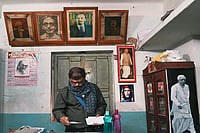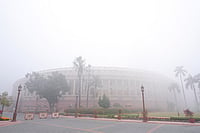It marks the beginning of the end of the Great Gulf Boom. For, powerful waves of nationalism—called Saudiisation, Omanisation and Emiratisation—are sweeping across countries in West Asia. And there's a sense of desperation among these governments to replace foreign workers (including millions of Indians) with locals. The reason: huge unemployment that has led to growing civil unrest, higher crime rates and increasing hatred for the ruling classes. In the near future, it could prove to be the end of the road for massive labour flows from India to the Gulf region.
To gauge the extent of the problem, look at a few decisions taken by the Saudi Arabia regime. A few weeks ago, it told employers in 21 segments to have a fully Saudiised workforce by 2006. This is expected to create 2,00,000 jobs for locals. Then, jewellery shops were barred from employing foreigners as salesmen and administrators; a move that will open up another 20,000 jobs. Finally, local banks have to get rid of their 10,000 foreign workers. By 2013, Saudi Arabia hopes to reduce its expat population of 7 million—including 1.4 million Indians—by 40 per cent.
Such moves are not restricted to Saudi Arabia alone. "All the gcc countries are pursuing national policies to hire their own people," says an Indian diplomat in the region. So, the impact will be felt by the 3.5 million Indians—who constitute the largest community among all foreign nationals—in the region. More importantly, it'll hurt the Indian economy. Remember, remittances from just Saudi Arabia-based Indians, the bulk of whom are Keralites, total $7 billion every year. And this forms a sizeable 9 per cent of India's forex reserves.
Koshi Joseph, president of the Pravasi (Expatriate) Malayalee Council, feels 50,000 Indians may return from Saudi Arabia this year. That explains why M.M. Hassan, Kerala's norka (Non-Resident Keralites Affairs) minister, sent a fax to the Union external affairs ministry urging the latter to take steps to minimise the impact of the returning emigrants. Hassan is also expected to visit Saudi Arabia next month. In June, academicians from the state will also go there to make an impact assessment of the growing Arabisation.
The fact is the pitch of the nationalistic fervour can only increase because the numbers of unemployed locals in the region is rising by the day. For instance, in Saudi Arabia, unemployment among the male population has nearly doubled to 12 per cent within the past three years. A few economists, like the ones in Saudi American Bank, put the figure at 15 per cent. (Unemployment among women is obviously much higher.) In contrast, the number of expat workers is going up. "Today, over 70 per cent of the total workforce in Saudi Arabia is made up of foreigners," say diplomatic sources.
What's more worrisome is, as some economists term it, the phenomenon of 'youth bubble'. It's called that since unemployment among the youth (15-25 years) is double that of the figure for the total Saudi male workers. As younger people today constitute the majority, the problem gets accentuated with unrest among this group. Studies have found that this segment is the most vociferous in criticising the ruling Saudi regime. The unemployed youth are also responsible for most of the crimes, which too have been growing at 15-20 per cent every year.
This social crisis has other economic costs as well. Economists believe the real cost of low Saudi labour participation could be as high as $47 billion on an annual basis. What it implies is that this is the money that could flow into the Saudi economy if locals, and not expats, held most of the jobs. This happens essentially because expats save most of what they earn and send them back to their respective countries as remittances.However, Saudis spend most of their salaries in the country; studies indicate every 1,000 riyals earned by a local leads to additional income generation of 1,500 riyals. Moreover, if this money circulates inside the country, it can lead to increased demand for other goods and services, thereby boosting the private sector. That, in turn, will provide further fillip to the economy.
Indian labour is under attack due to its sheer size. Indians form as much as 7-8 per cent of Saudi population. The second-largest brood of foreign nationals are from Egypt (800,000, or 4 per cent). Since the country has always tried to ensure that no foreign group should become "so large so as to overwhelm others", it is concerned about the Indians. "Saudi Arabia, like other Gulf countries, wants to rectify the demographic imbalance in the kingdom," explains S. Irudaya Rajan, associate fellow at the Kerala-based Centre for Development Studies.
Well, the Saudi rulers were not worried as long as the economy was growing through increasing oil revenues and the government was in a position to offer jobs to Saudis. Things changed in the 1990s as public jobs (90 per cent of which go to locals) started shrinking and the private sector (where expats form a huge majority) was unwilling to hire locals. The problem with hiring locals was they had to be paid higher (at least twice) than the foreigners. In addition, they were unwilling to do menial jobs and had little skills for white-collar ones.
Today, the situation has changed and the Gulf nations are being forced to take corrective action. However, Indian diplomats in the Gulf as well as policymakers in New Delhi still see a bright light at the end of the tunnel. To begin with, they think the gcc nations will find it difficult to implement their own decisions. "In the past, we have seen similar policies that have not yielded any results. In fact, the Saudiisation process has been in action for two decades," says a senior official in the external affairs ministry.
For example, a few years ago, taxi owners in Saudi Arabia were asked to recruit only locals. That was aimed at opening up 75,000 jobs. But none of the owners seriously pursued it and they claimed that no Saudi wanted to become a taxi driver. It's only recently that the rulers have decided to enforce the policy and owners have been given a short time-frame to do it. Similarly, the jewellery shop policy was introduced earlier, but found no takers. The reason: there were no skilled Saudis to work as assistants in these outlets.
But according to local experts, these are simply myths perpetrated by foreigners. For example, Kevin Taecker, an independent consultant who has earlier worked with Saudi American Bank, feels: "The reality is that the Saudi labour market is going through a long-anticipated and planned-for transition. The process is extensively supported by the government." He adds that even the salaries of Saudis and expatriates are converging and the differential is becoming smaller.
Indian policymakers also contend that most of the current policies are likely to hit white-collar jobs; therefore, the majority of the semi-skilled labour will continue to thrive. Here too, there's a catch. The number of people going to Saudi Arabia has been declining since the mid 1990s—from 2.69 lakh in 1993 to around a lakh today. But remittances have gone up, indicating that the contributions from higher-paid, skilled workers were on the increase. So if the white-collared Indians are forced to leave the Gulf region, the impact on the Indian economy will be greater.
On the flip side, people like Koshi of the Pravasi Malayalee Council think the demand for skilled workers will increase, rather than go down. Whatever may be the case, they should realise one grim truth.In the near future, the number of Indians in the Gulf can only come down. And it's indeed the beginning of the end of the Grand Gulf Dream.
Return Of The Native
India's Gulf boom might end with the Arab world further nativising its workforce

Return Of The Native
Return Of The Native
Published At:
MOST POPULAR
WATCH
MORE FROM THE AUTHOR
×




















